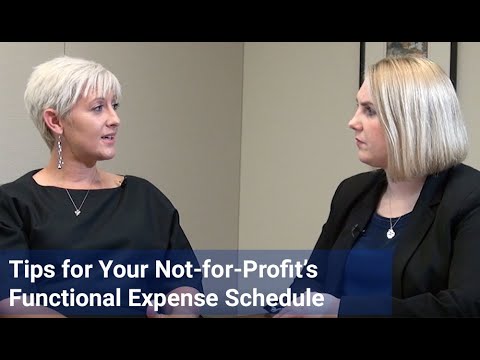Tips for Your Not-for-Profit’s Functional Expense Schedule

Jen: This is the PKF Texas Entrepreneur’s Playbook. I’m Jen Lemanski, and I’m back once again with Nicole Riley, one of our audit senior managers and one of the faces of PKF Texas’ Not-for-Profit team. Nicole, welcome back to the Playbook.
Nicole: Great to be back.
Jen: So, I’ve heard you in presentations talk about the functional expense schedule for not-for-profits. What is this and what do not-for-profits need to know about it?
Nicole: So, it’s an old requirement for some but a very new requirement for others, because the new accounting rules that went into effect in 2018 made this a requirement for all nonprofits, whereas previously it was only some. So, what a functional expense schedule is, is where you have to report your expenses by natural classification, which means salaries and benefits, rent, utilities, those basic categories of expenses that you usually see. But then also you have to show the functional categories, which is program, management in general and fundraising. And whereas a program is usually, it’s the mission of the organization and it’s why they exist, so those are expenses to actually perform the mission.
Management in general is more oversight expenses, the governance, the bookkeeping, accounting department, HR – those are more management general functions. And then you also have fundraising or could be membership development if you’re a membership organization. And of course, those are the money that you have to pay and that you incur to raise dollars for the organization.
Jen: So, are there any tips or suggestions you have for organizations to get this information pulled together?
Nicole: Well, I really recommend organizations start with identifying those direct costs, making sure that their accounting software is set up so the direct items automatically get coded not only to salaries and benefits expense line, but are also coded to the program that they’re benefiting or – if it’s management in general, that we right from the back get those into the right categories.
Then you have to think about the ones that are going to have to be allocated. Obviously the biggest one that most organizations have is salaries and benefits, you know, a lot of work force. So, you have to really consider what is it that the individuals are doing and a lot of times it’s, you can look at it on a department level if you’re a larger organization. The smaller organizations are going to look at person by person and you got to come up with a reasonable allocation, you know, how much time over a year does our executive director spend on fundraising. And how much time do they spend maintaining the programs and helping the programs staff.
So, just you have to really come up with some allocation bases and from there also then going into the other expenses rent, utilities, a lot of methodologies tend to go, you know, who uses the building. If education is using the top half of the building, and it’s a two-story building…
Jen: Who’s using the bottom?
Nicole: Well, 50 percent should go to the education department. So, you really have look at the nuts and bolts of who’s using stuff in what’s going on. But, in general, my biggest tip is make sure that your expense allocation is reasonable, that you consistently apply it and that it’s documented. Those are the biggest things, and if an organization can get that into place, they’re going to be 99 percent there.
Jen: Great. Well, we will get you back to talk about some more not-for-profit topics soon.
Nicole: Thanks.
Jen: For more information about how PKF Texas can help your not-for-profit organization, visit www.pkftexas.com/NotForProfit. This has been another Thought Leader production brought to you by the PKF Texas Entrepreneurs Playbook. Tune in next week for another chapter.

